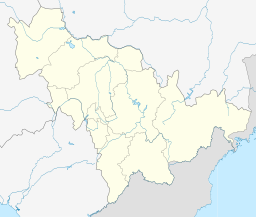geo.wikisort.org - Reservoir
Chagan Lake (Chinese: 查干湖; pinyin: chágān hú) is a lake in Jilin, China. The name "Chagan" is from Mongolian (ᠴᠠᠭᠠᠨ
ᠨᠠᠭᠤᠷ, transliteration : Chaɣan naɣur, Cyrillic mongolian : цагаан нуур, transliteration MNS : tsagaan nuur), meaning white / pure lake (see also Chagan River re. another toponym including the Mongolian adjective tsagaan). It is often referred to as the Sacred Lake or Holy Water Lake (simplified Chinese: 圣水湖; traditional Chinese: 聖水湖; pinyin: shèngshuǐ hú) by local people. The lake is known for its traditional winter fishing, featuring a technique which dates back to prehistoric times.[citation needed]
This article needs additional citations for verification. (August 2018) |
| Chagan Lake | |
|---|---|
 Chagan Lake | |
| Location | Jilin, China |
| Coordinates | 45.25°N 124.28°E |
| Native name | 查干湖 (Chinese) |
| Basin countries | China |
| Surface area | 307 km2 (119 sq mi) |
| Average depth | 4 m (13 ft) |
| Water volume | 415×106 m3 (14.7×109 cu ft) |
Chagan Naoer winter fishing tradition
Chagan Lake is the only place in which the oldest of Mongolian fishing methods is preserved. It is listed as a National Intangible Cultural Heritage of the People's Republic of China.
The annual Winter Fishing Festival is held to keep this ancient tradition alive.[1] Fishermen first drill many holes through the thick ice and then use these holes to carefully position a 2 km net under the ice. The net and its catch is then hauled out of the largest hole by means of a capstan (see also Whim (mining)) turned by Mongolian horses. The Lake set a Guinness World Record of a single net that yielded 104,500 kg (230,400 lb) of fish in 2006, and broke its own record with 168,500 kg (371,500 lb) of fish in 2009. The principal species thus netted is the Bighead carp - a popular food fish, particularly at the Chinese New Year, when the consumption of fish is considered to bring good fortune in the year to come.[2]
References
- "(in Chinese) CCTV Special Program: Chagan Lake Winter Fishing Festival". Archived from the original on 2021-12-20.
- "Fishermen Are Fishing in Chagan Lake - Chagan Lake Photos, Chagan Lake Winter Fishing Jilin China". www.icefestivalharbin.com (in Chinese (China)). Retrieved 2018-09-05.
На других языках
[de] Qagan Pao
Der Qagan Pao oder Chagan-See[2] (chinesisch .mw-parser-output .Hani{font-size:110%}查干泡, Pinyin Chágān Pāo, umgangssprachlich 查干湖, Chágān Hú bzw. mongolisch umgangssprachlich auch Qagan Nur „Weißer See“) ist ein Süßwassersee im Autonomen Kreis Vorderer Gorlos der Mongolen im Verwaltungsgebiet der bezirksfreien Stadt Songyuan in der chinesischen Provinz Jilin. Er ist der größte Binnensee der Provinz Jilin und etwa ⅔ so groß wie der Bodensee. Damit zählt der Chagan-See zu den zehn größten Süßwasserseen Chinas. Eine touristische Attraktion ist das jährliche Qagan-See-Winterfischfest. Es steht auf der Liste des immateriellen Kulturerbes der Volksrepublik China.- [en] Chagan Lake (China)
[fr] Lac Chagan (Chine)
Le Lac Chagan (.mw-parser-output .sep-liste{font-weight:bold}mongol : ᠴᠠᠭᠠᠨᠨᠠᠭᠤᠷ, VPMC : Chaɣan naɣur, cyrillique : цагаан нуур, MNS : tsagaan nuur, littéralement : Lac blanc ; en chinois, il est translittéré du mongol seulement par son nom propre : chinois : 查干湖 ; pinyin : chágān hú ; litt. « Lac Chagan » ou le terme lac également : pinyin : chágān nàoěr) est un lac situé sur le territoire de la ville-préfecture de Songyuan, au nord-Ouest de la province du Jilin, dans le Nord-Est de la République populaire de Chine. Ce lac est également proche de la Mongolie-Intérieure, ce qui explique son nom mongol.[ru] Цаган-Нур (озеро, Гирин)
Цаган-Нур — озеро на севере Китая.Другой контент может иметь иную лицензию. Перед использованием материалов сайта WikiSort.org внимательно изучите правила лицензирования конкретных элементов наполнения сайта.
WikiSort.org - проект по пересортировке и дополнению контента Википедии